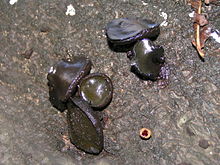Bulgaria inquinans
| Bulgaria inquinans | |
|---|---|

| |
| Scientific classification | |
| Kingdom: | |
| Division: | |
| Class: | |
| Order: | |
| Family: | |
| Genus: | |
| Species: | B. inquinans
|
| Binomial name | |
| Bulgaria inquinans | |
| Synonyms | |
| |
| Bulgaria inquinans | |
|---|---|
| Cap is depressed | |
| Hymenium attachment is not applicable | |
| Lacks a stipe | |
| Spore print is blackish-brown | |
| Ecology is saprotrophic | |
| Edibility is not recommended | |
Bulgaria inquinans is a fungus in the family Bulgariaceae. It is commonly known by the name black bulgar and Black Jelly Drops.[1][2]
It grows on branches and bark of dead oak and hornbeam. It has also been growing on ash trees due to ash dieback disease.[2] The species can be found from October to March. It can be commonly found on felled trees stored in timber yards. Research into the colouring materials found in the fungus by H.Lockett and R.Edwards at Bradford University gave name to three purple pigments as two bulgarhodins and bulgarein.[3]
Description[2]
The cap of Bulgaria inquinans generally has a diameter between 0.5 and 4 cm (0.19 in to 1.6 in). It has a flat top when young but later become more cupped. These mushrooms generally grow in medium sized clusters on dead trees, generally Oak and Hornbeam, but also Ash Trees. The texture of the mushroom is similar to leather or elastic, depending on dry weather (elastic like), or wet weather (leather). It grows across mainland Europe and in the British Isles, It also grows in parts of the United States.
Gallery
-
Young version
References
- ^ Sterry, Paul; Hughes, Barry (2009). D & N Publishing (ed.). Collins Complete Guide to British Mushrooms & Toadstools. London: HarperCollins. p. 306. ISBN 978-0-00-723224-6.
- ^ a b c "Bulgaria inquinans, Black Bulgar fungus". www.first-nature.com. Archived from the original on 2019-07-31. Retrieved 2019-10-09.
- ^ Edwards RL, Lockett HJ. (1976). "Constituents of the Higher Fungi. Part XVI. Bulgarhodin and bulgarein, novel benzofluoranthenequinones from the fungus Bulgaria inquinans". Journal of the Chemical Society, Perkin Transactions 1: 2149–55. doi:10.1039/p19760002149.
External links





